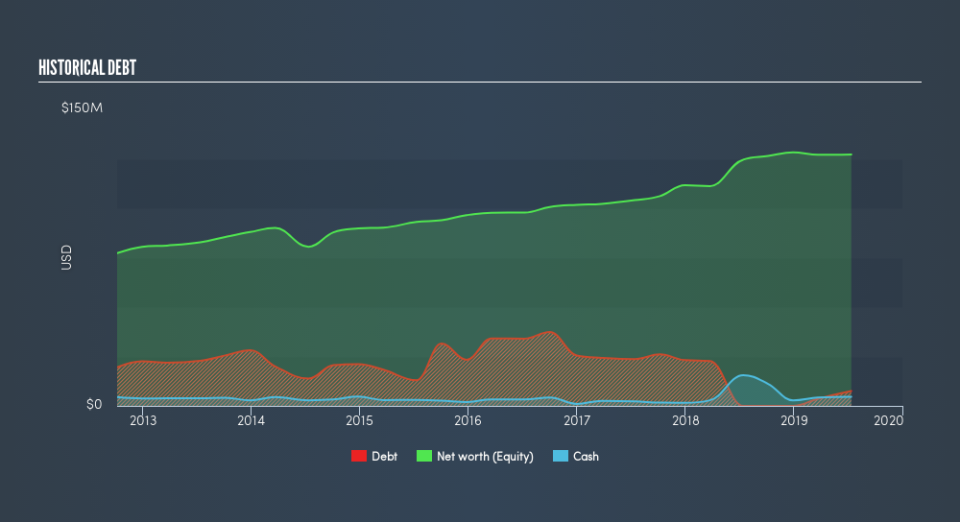These 4 Measures Indicate That Escalade (NASDAQ:ESCA) Is Using Debt Reasonably Well

Warren Buffett famously said, 'Volatility is far from synonymous with risk.' So it seems the smart money knows that debt - which is usually involved in bankruptcies - is a very important factor, when you assess how risky a company is. Importantly, Escalade, Incorporated (NASDAQ:ESCA) does carry debt. But should shareholders be worried about its use of debt?
When Is Debt A Problem?
Generally speaking, debt only becomes a real problem when a company can't easily pay it off, either by raising capital or with its own cash flow. In the worst case scenario, a company can go bankrupt if it cannot pay its creditors. However, a more frequent (but still costly) occurrence is where a company must issue shares at bargain-basement prices, permanently diluting shareholders, just to shore up its balance sheet. By replacing dilution, though, debt can be an extremely good tool for businesses that need capital to invest in growth at high rates of return. When we examine debt levels, we first consider both cash and debt levels, together.
View our latest analysis for Escalade
What Is Escalade's Net Debt?
You can click the graphic below for the historical numbers, but it shows that as of July 2019 Escalade had US$7.53m of debt, an increase on none, over one year. However, it does have US$4.60m in cash offsetting this, leading to net debt of about US$2.93m.
How Strong Is Escalade's Balance Sheet?
We can see from the most recent balance sheet that Escalade had liabilities of US$15.7m falling due within a year, and liabilities of US$12.5m due beyond that. Offsetting these obligations, it had cash of US$4.60m as well as receivables valued at US$35.2m due within 12 months. So it actually has US$11.6m more liquid assets than total liabilities.
This short term liquidity is a sign that Escalade could probably pay off its debt with ease, as its balance sheet is far from stretched.
We measure a company's debt load relative to its earnings power by looking at its net debt divided by its earnings before interest, tax, depreciation, and amortization (EBITDA) and by calculating how easily its earnings before interest and tax (EBIT) cover its interest expense (interest cover). This way, we consider both the absolute quantum of the debt, as well as the interest rates paid on it.
Escalade's net debt is only 0.17 times its EBITDA. And its EBIT easily covers its interest expense, being 48.0 times the size. So you could argue it is no more threatened by its debt than an elephant is by a mouse. Escalade's EBIT was pretty flat over the last year, but that shouldn't be an issue given the it doesn't have a lot of debt. The balance sheet is clearly the area to focus on when you are analysing debt. But you can't view debt in total isolation; since Escalade will need earnings to service that debt. So when considering debt, it's definitely worth looking at the earnings trend. Click here for an interactive snapshot.
But our final consideration is also important, because a company cannot pay debt with paper profits; it needs cold hard cash. So the logical step is to look at the proportion of that EBIT that is matched by actual free cash flow. Looking at the most recent three years, Escalade recorded free cash flow of 49% of its EBIT, which is weaker than we'd expect. That weak cash conversion makes it more difficult to handle indebtedness.
Our View
Happily, Escalade's impressive interest cover implies it has the upper hand on its debt. And we also thought its net debt to EBITDA was a positive. When we consider the range of factors above, it looks like Escalade is pretty sensible with its use of debt. That means they are taking on a bit more risk, in the hope of boosting shareholder returns. Given Escalade has a strong balance sheet is profitable and pays a dividend, it would be good to know how fast its dividends are growing, if at all. You can find out instantly by clicking this link.
If you're interested in investing in businesses that can grow profits without the burden of debt, then check out this free list of growing businesses that have net cash on the balance sheet.
We aim to bring you long-term focused research analysis driven by fundamental data. Note that our analysis may not factor in the latest price-sensitive company announcements or qualitative material.
If you spot an error that warrants correction, please contact the editor at editorial-team@simplywallst.com. This article by Simply Wall St is general in nature. It does not constitute a recommendation to buy or sell any stock, and does not take account of your objectives, or your financial situation. Simply Wall St has no position in the stocks mentioned. Thank you for reading.

 Yahoo Finance
Yahoo Finance 
